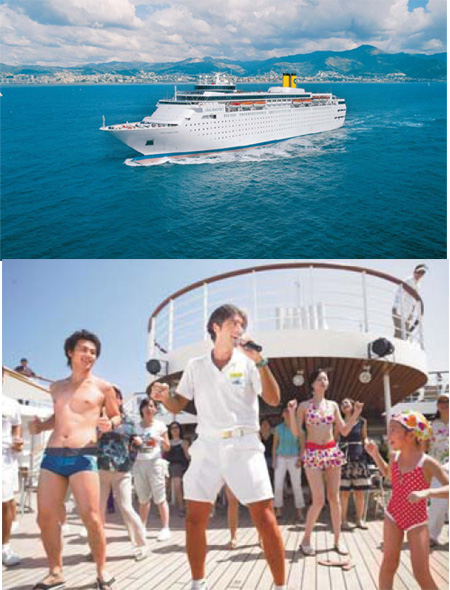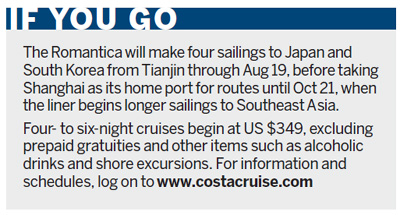The joy of being all at sea
By Brad Webber (China Daily)
Updated: 2010-08-02 10:10
 |
Large Medium Small |

Cruising is a relatively new travel experience for Chinese holiday-makers. Brad Webber joins a cruise and enjoys watching his fellow passengers as much as the sights.
As the Costa Romantica carved through the Yellow Sea at 19 knots per hour, its 360-degree observation lounge lent a bird's-eye view of the calm but silt-filled waters a dozen decks below.
On the horizon were the coastlines of China, South Korea and Japan.
But the real sights were on the deck, in the casino, the seven bars, two swimming pools, whirlpool Jacuzzis and the shopping arcade.
My recent voyage on the 56,800-ton ocean-liner opened my eyes to a new phenomenon - Chinese revelers lapping up the delights of a classic cruise ship including Vegas-styled revues, acrobatic performances, dance and cooking lessons and, of course, an abundance of victuals.
The water's just fine, said many of the Chinese passengers - almost all of whom were taking their first voyage. They've got money to spend, and they flashed it onboard and as they returned from port calls in Jeju, South Korea, and Fukuoka, Japan, heavily laden with shopping bags.
By 2020, China will be the fourth-largest source of outbound travelers, according to the World Tourism Organization. The cruise industry aims to tap into the market with more and bigger ships, even as the Chinese government itself ponders launching a cruise line to compete with the Western companies.
These include Costa Crociere S.p.A., an Italian line partially owned by Carnival Corp and Royal Caribbean International, both of which offer dozens of seasonal sailings originating from mainland ports.
Interest in cruising surged after scenes from the hit romantic comedy If You Are the One were filmed aboard a Costa ship. Will that help presage a boom much like the one in the US after The Love Boat television series hit the airwaves in the late 1970s?
"Costa is the pioneer, the first one operating in this market. We were the ones introducing the cruise concept," Leo Liu, the dapper general manager of China, Pacific Asia operations for Costa, said during an earlier interview in Beijing. "The work done by Costa is getting results. We opened up the market and we see other players coming in as a good sign.
"The first job in marketing is the educational process. During the cruise, you have a gala dinner, a captain's dinner and a theme dinner, and we are seeing the progress of our Chinese guests.
"Three years ago, people joined the captain's dinner in pajamas and slippers. Of course, we couldn't say anything because they are our guests, but we needed to do a lot of educating. Training our agencies, partners, to say, 'OK guys, please, there is also a social code we need to respect."
So far, the number of Chinese cruisers is still a mere drop in the ocean against the backdrop of the industry's 13.5 million guests aboard 300 oceangoing passenger vessels in 2009, according to the Cruise Lines International Association, a Florida-based trade group that notes that some 75 percent of cruisers are North Americans on rum-swizzled Caribbean routes.
But to the nearly 1,400 Chinese passengers who joined me on the Romantica's five-night inaugural cruise from the new Tianjin International Cruise Terminal, the only numbers that mattered preceded B, I, N, G and O.
At one point I wondered if the ship would capsize as guests rushed starboard for game cards.
This was not laowai oriented, and I was one of only about two dozen Westerners. As a member of the "minority" I was invited to meet Captain Pietro Sinisi in his spacious office near the ship's bridge. At 39, he is the youngest captain in the Costa fleet of 14 vessels, and the master of 564 crew from 84 countries. His effort to speak a couple lines of Mandarin during his welcome address garnered whoops of approval.
"Chinese people seem to enjoy cruising more than all the others," Sinisi told me, noting the lively atmosphere in the Piazza Italia grand bar during the games.
Food is critical to the cruise experience, doubly so on a ship full of Chinese, and the Chinese executive chef, Wang Zhaorong, was accorded celebrity status as he paraded around the lido deck on the penultimate day of the cruise, hoisting the Chinese colors to
wild applause as the World Cup soccer theme song, Wavin' Flag, blared on the top deck.
Taking "Cruising Italian Style" (the line's motto) to heart was also evident in the expansive Botticelli Restaurant. Diners waved their napkins as waiters crooned standbys such as O Sole Mio, Volare and That's Amore and lustily applauded their favorite servers.
For a cruise line famed for toga parties, fun is cut from whole cloth and the ship's team of young "animators" were grabbing passengers to join the line dances.
As they artfully high-stepped to Achy Breaky Heart, I was surprised they knew the Billy Ray Cyrus country song. Then I realized that they were just really good at following directions.
By the voyage's end, most had loosened up and more had picked up that urge to move along the line to the beat of more country songs circa 1990s.
These passengers, at least, were not all at sea.
